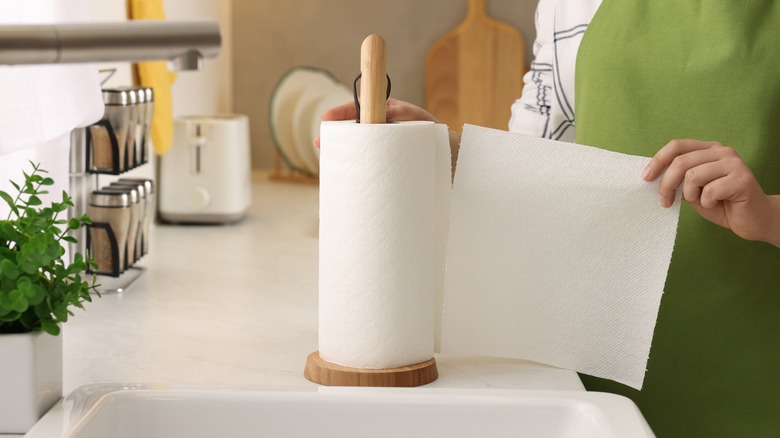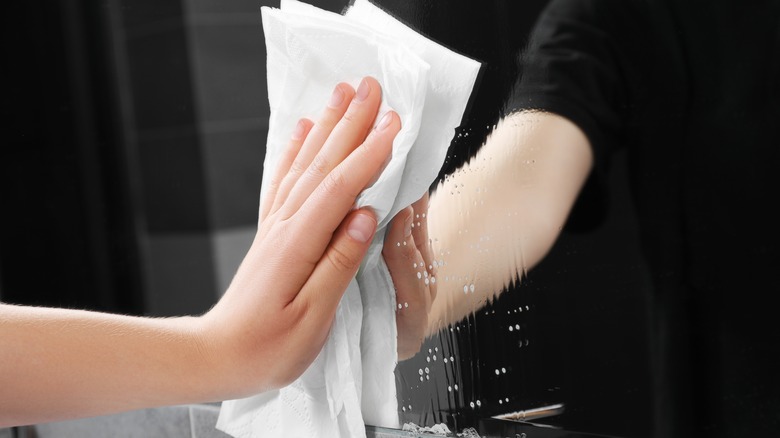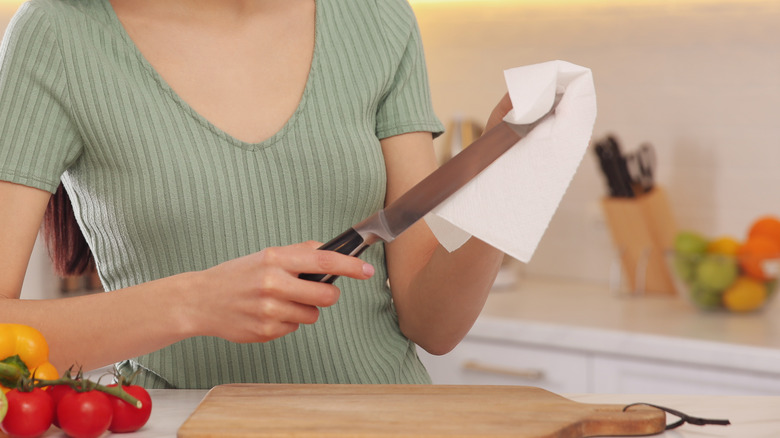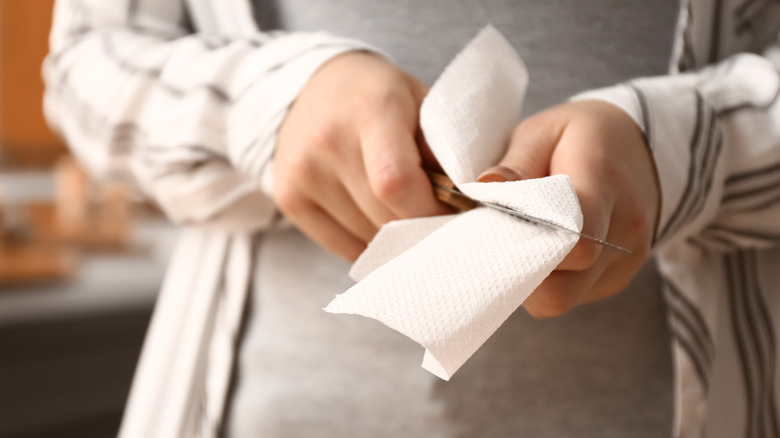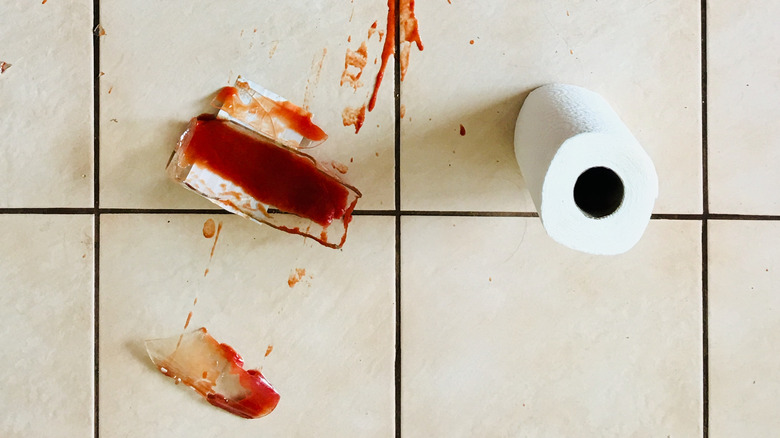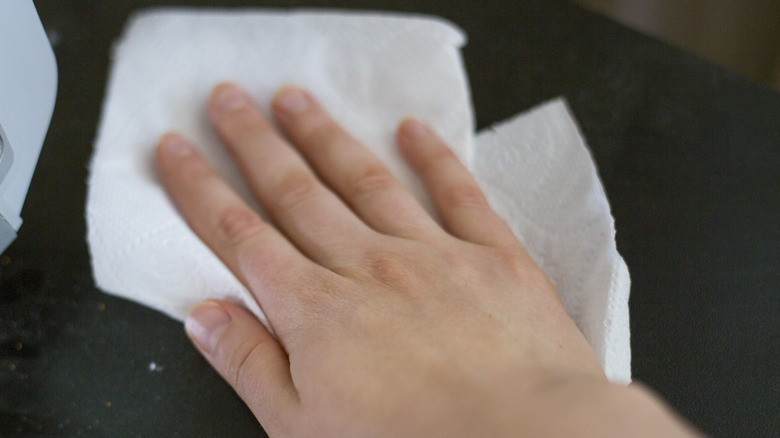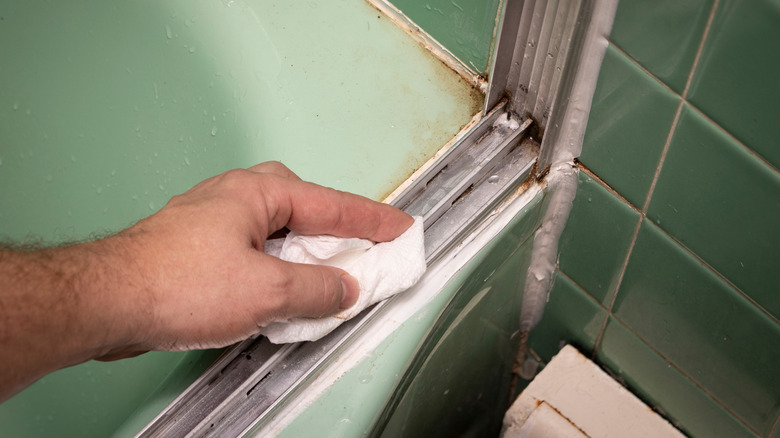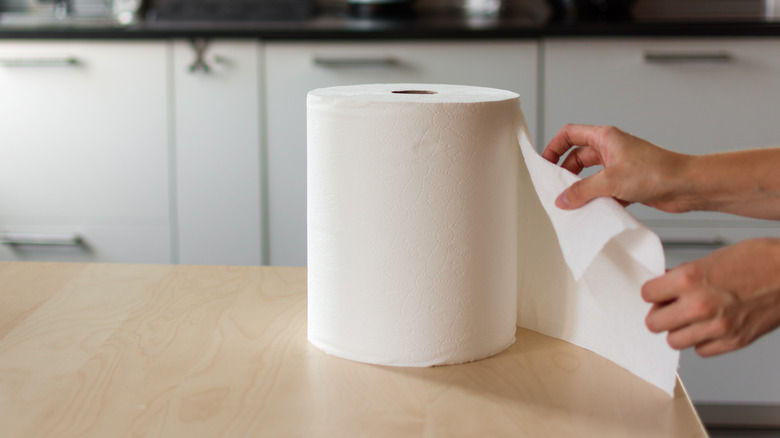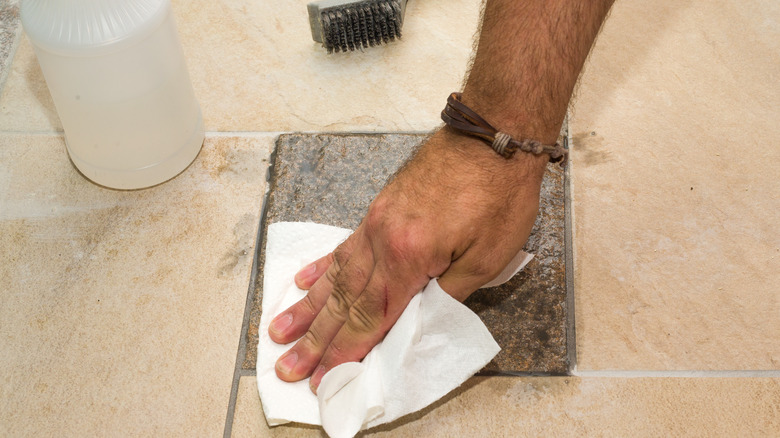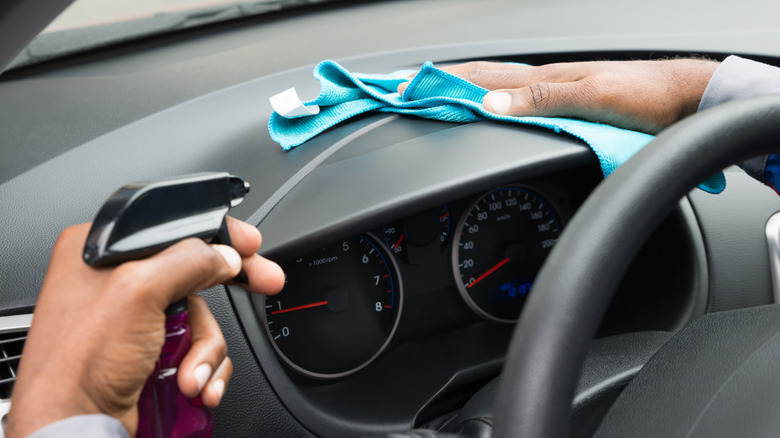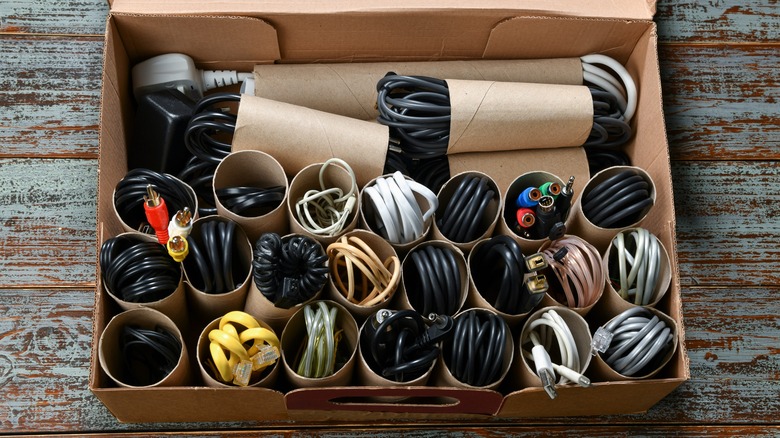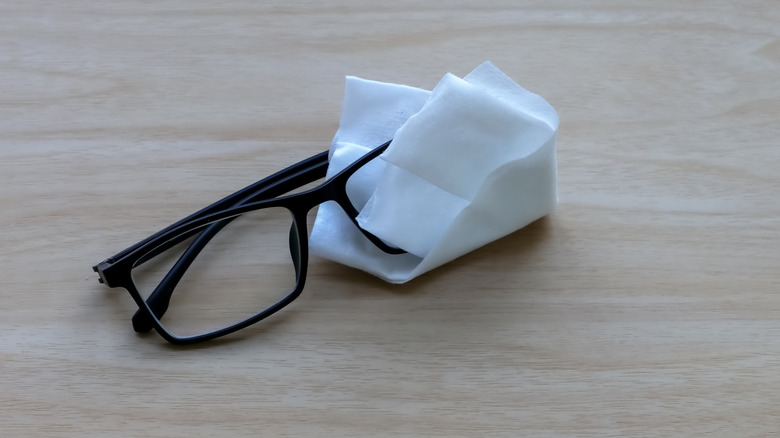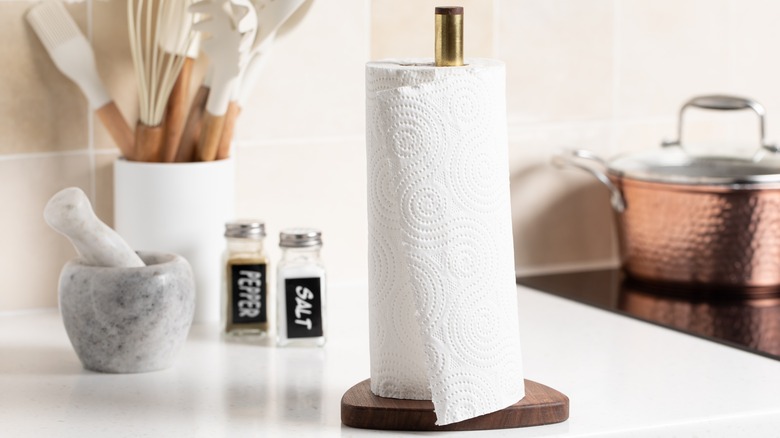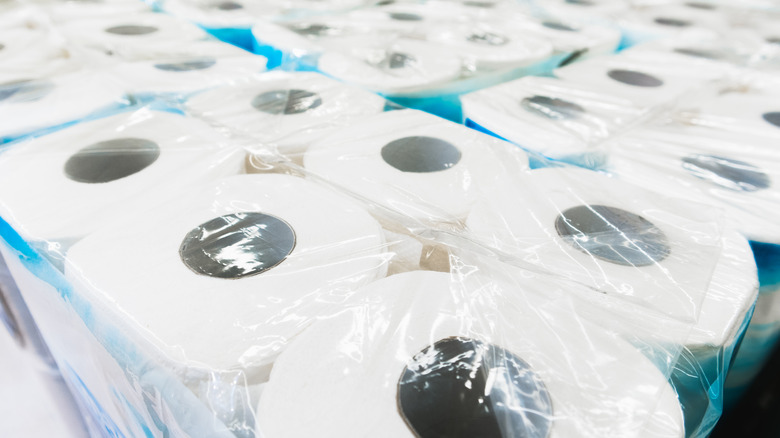Paper Towel Mistakes You Didn't Realize You Were Making
Paper towels were invented by the Scott Paper Company in 1907 as a way to use up a trainload of unusable toilet paper. Since then, the number of American households that use paper towels has continued to increase. In fact, Statista reports that over 331 million Americans are expected to use the convenient product in 2024. Based on these numbers, chances are good that you have at least one set of paper towels on your pantry shelf right now.
While paper towels are quite versatile, they're often used (and even purchased) incorrectly. These mistakes can waste consumers' money and even damage items during the cleaning process. For example, you should generally avoid cleaning eyeglasses, mirrors, and car windshields with paper towels. You should also purchase this product based on its cost per square foot rather than its number of sheets. Let's see if you've made any of these paper towel mistakes — and figure out what you can do instead.
Cleaning mirrors and windows
Mirrors are prone to fingerprints, dust, and splattered toothpaste; similarly, windows can easily accumulate dust and can be plagued with dirt and bugs. To clean these messes quickly, most homeowners grab a roll of paper towels and a bottle of window cleaner. While this method will certainly clean the existing debris on these surfaces, it will also leave behind lint. Fortunately, you have a few other options, such as using a piece of newspaper or a microfiber towel. These provide an excellent clean without the residual lint.
In addition to choosing between a newspaper or microfiber towel, you'll also need to make sure you're using a glass cleaner and not an all-purpose cleaner. This is because the surfaces of your mirrors and windows are prone to streaks. Once you have the right cleaner, spray a little on your glass and start wiping either up and down or left to right with your chosen material. You may need to repeat this process if the surface is heavily soiled. As an additional note, if you're washing tinted car windows, make sure you're using an ammonia-free glass cleaner.
Wiping down sharp knives
When preparing dinner for your family, you may find yourself cutting beef into strips for fajitas or chopping chicken into cubes for an Alfredo dish. While grabbing a paper towel to quickly wipe the meat's juice off of your blade may be tempting, it's not advisable. This is for several reasons: Not only is the blade likely sharp enough to pierce through the paper towel and possibly make contact with your skin, but the paper towel will also leave lint on the blade's surface. Working with raw meat also requires more thorough cleaning than simply wiping down the knife.
After preparing your food, wash the knife with dish soap and hot water. Immediately afterward, dry it off with an absorbent dish towel. Some knives are listed as dishwasher safe, but in general, it's best to hand-wash them instead. This is because dishwashers can dull blades, damage wood and plastic handles, and potentially lead to rust.
Buffing silverware
Throwing a dinner party can be fun, but it does require a bit of preparation. You may be tempted to speed up the process of buffing the silverware for your place settings with a few paper towel sheets, but this is not advisable. While they can be used to clean the wooden handles on silverware sets, they should never be used on the silver itself, as the paper will scratch the metal. Instead, use a polishing cloth or a cellulose sponge.
If your silverware needs cleaning, first wash it with a little dish soap and water. Make sure you dry it immediately afterward — a lint-free dish towel works best for this task. Your cutlery set will then be ready for polishing. Apply silver polish to each piece and rub it in using a cellulose sponge. Rinse the silverware clean before buffing it with a dry, unused cotton dish towel.
Not wetting paper towels before cleaning broken glass
Whether you set your glass down too hard or accidentally drop it on the kitchen floor, you'll likely have to clean up glass shards at one time or another. Even when homeowners try to clean up broken glass safely, however, they often make the mistake of reaching for a dry paper towel to scoop up tiny glass pieces. Unfortunately, broken glass won't stick to dry paper towels, and the tiny shards can easily rip through the material. Instead, dampen the paper towel before you attempt to clean up the glass fragments.
Before you start the clean-up process, don a pair of thick gloves for added safety. Then, place several paper towel sheets on top of each other. Fold the sheets in half two times to form a square. Wet the wad of paper towels and press it over the tiny pieces of glass. They should stick to the paper without cutting through its many layers. Toss the paper towels in the trash and repeat if you still have more glass to clean up.
Cleaning rugs and carpet stains
Spills are inevitable, especially if you have pets or small children. If something spills on your area rug or living room carpet, your first instinct may be to grab a roll of paper towels and start blotting up the mess. This option isn't ideal, however, as the paper towel will crumble when you try to wipe with it, lodging tiny pieces of paper in between the carpet fibers. For this reason, a sponge is a better tool for the task.
As soon as possible after you notice a spill, dab a sponge over the liquid to sop it up. For larger spills, you may need to wring it out in the sink and repeat the process. Flush the area with water and then blot it dry with a clean microfiber towel. If you have a carpet shampooer, you can also use that for a deep clean, as these machines are designed to draw up messes from the bottom of your rug.
For darker stains like coffee or tea, you may also want to apply a homemade cleaning solution before flushing the fibers clean with water. To make one such solution, simply combine 1 cup of warm water, 1 tablespoon of white distilled vinegar, and a few drops of your preferred dish soap.
Removing grime from slider door tracks
Sliding glass shower doors are not only sleek-looking but also cost-effective, as you don't need to continuously replace liners and curtains. The downside of this bathroom design choice, however, is the tracks, which easily collect soap scum, dirt, and hair. Cleaning this mess with paper towels is a mistake, as they not only leave behind lint that could affect the sliding door's ability to open and close, but they also aren't strong enough to remove all of the grime. Cotton balls and toothbrushes are a much better option for cleaning this part of your bathroom.
Soak a few cotton balls in distilled white vinegar. This isn't just a powerful cleaner — it can also kill a few germs, such as E. coli. If you feel the need to fully disinfect your shower tracks, opt for isopropyl alcohol instead, as vinegar isn't registered as a disinfectant. Wipe down the tracks with the moistened cotton balls, and use a toothbrush to scrub any spots the cotton balls can't reach. Flush the tracks with some hot water, and you're all done!
Using a large sheet when less paper towel will do
One cleaning mistake many people make is using more paper towels than they need. It's easy to just grab a sheet off of the roll to clean up an unexpected mess, but this is often wasteful, as you may only require a small amount of paper. Try tearing a large sheet in half for small tasks, like blotting your lipstick or wiping a few drops of coffee off of the counter.
As for cutting back on your paper towel use, start by tearing away a few of the perforated sheets. Then, grab a pair of scissors and cut the perforated sheets in half. That way, when you just need a little bit of paper, you have some at the ready. You can also rip off smaller amounts of a paper towel as needed. So, if you only need a corner of a paper towel sheet to squish a bug, just rip that portion off and leave the rest of the sheet for bigger jobs.
Cleaning grout
Kitchen backsplashes can easily become dirty when you're cooking — maybe your spaghetti sauce splatters outside of the pan or some sizzling bacon grease pops and lands on the wall. Wiping these messes up with paper towels may seem like a good idea, but in reality, paper towels should never be used to clean grout. This material is rough and will rip the paper towels as you clean, causing an even bigger mess. Towels or toothbrushes are much better choices.
When your grout needs cleaning, grab a soft-bristled toothbrush and dip it in a bowl of hot, soapy water. Scrub away the dirt and grime and then wipe the grout clean with a lint-free cloth. Another option is to use a grout sponge, which is specially designed for this task. These sponges usually cost just a few dollars at your local home improvement store and can be washed and reused many times.
Wiping down your dashboard
The first thing you likely want to do when preparing for a road trip is clean your car's interior. For this task, many people start with the dashboard, a spray cleaner, and a roll of paper towels. This isn't the best option though, as paper towels aren't very effective on car interiors — they just push the dust around rather than lift it away. To properly clean your dashboard, you'll need a microfiber cloth and an interior car cleaner.
Spray the dashboard with your cleaner and wipe the surface with your cloth. Microfiber works best, as these rags are designed to capture dust without leaving any lint behind. They're also soft, so they won't leave any unsightly scratches. You likely won't be able to reach your entire dashboard in one go, so fully clean the left side before moving on to the right. As an additional note, don't use paper towels on your car's exterior either, as the paper's surface may harm the paint.
Discarding paper towel rolls
Whenever possible, it's good practice to find new ways to reuse old items. Tossing the cardboard tube of a used paper towel roll is a mistake, as they have myriad additional uses. One of these is crafts, especially if you have kids. Try painting or decorating them to transform them into something completely new. Not only is the process fun, but it's also educational.
You can also use your old paper towel rolls to help start seeds in your garden, create an art caddy for your child's desk, organize cables and cords in your home office, or even make a peanut butter bird feeder to hang from your front porch. As for kids' crafts, use the cardboard rolls to create rainsticks, snakes, castles, trees, and kaleidoscopes. Cut the rolls and create unique napkin rings for your next dinner party or crease the rolls to make heart shapes and use them as stamps.
Cleaning eyeglasses
It's generally good practice to wash your eyeglasses at least once a day. This removes lint, dirt, and oils and ensures that you can see through the lenses clearly. The materials you use to give your glasses their daily wash are equally as important. Paper towels, while convenient, are rough and can damage your eyewear's protective coating, so avoid using them if at all possible. Instead, use a microfiber lens cloth or a soft handkerchief for the task.
Before cleaning your glasses, make sure you wash your hands. Then, wet the glasses before rubbing a bit of dish soap over them with your fingers. Rinse the glasses until there's no evidence of soapy residue. Use a microfiber lens cloth or a lint-free towel to dry your eyeglasses immediately after washing. (A soft handkerchief works for this part, too.) When not in use, store your glasses in an eyeglass case.
Buying paper towels based on the number of sheets
When the time comes to buy a new pack of paper towels, one of the biggest mistakes you can make is not calculating the cost per square foot. Since each brand creates rolls with sheets of different sizes, a roll with 72 smaller sheets won't give you the same value as a roll with 72 larger sheets. To determine which pack of paper towels is the most budget-friendly, you'll have to calculate the cost per square foot.
Start by examining the paper towels' packaging to locate where it lists the square footage. The next number you need is the price for the entire package, which, of course, should be listed on the shelf where the paper towels are displayed. Then, divide that price by the number of square feet to get the cost per square foot. Repeat this equation with the other brands and compare their respective costs to see which option offers the best deal.
Not pinching the paper towels before you buy them
Brands will often use words like "mega roll," "jumbo," or "family size" on their paper towel packaging to make you think you're getting more sheets than you actually are. Don't be swayed by marketing lingo like this. To verify that you're actually getting a good deal (and in addition to calculating the cost per square foot), you should first squeeze the packaging — even TikTok agrees that failing to do so is a mistake.
Before tossing a package of paper towels in your shopping cart, pinch one of the rolls. The packaging should be thin enough that you can do this easily. If the paper towels don't have a lot of give, you can feel confident that you're getting what's being advertised. On the other hand, if you pinch the roll and can squeeze the sheets so that they all compress, you're paying for air and not getting a good deal.
